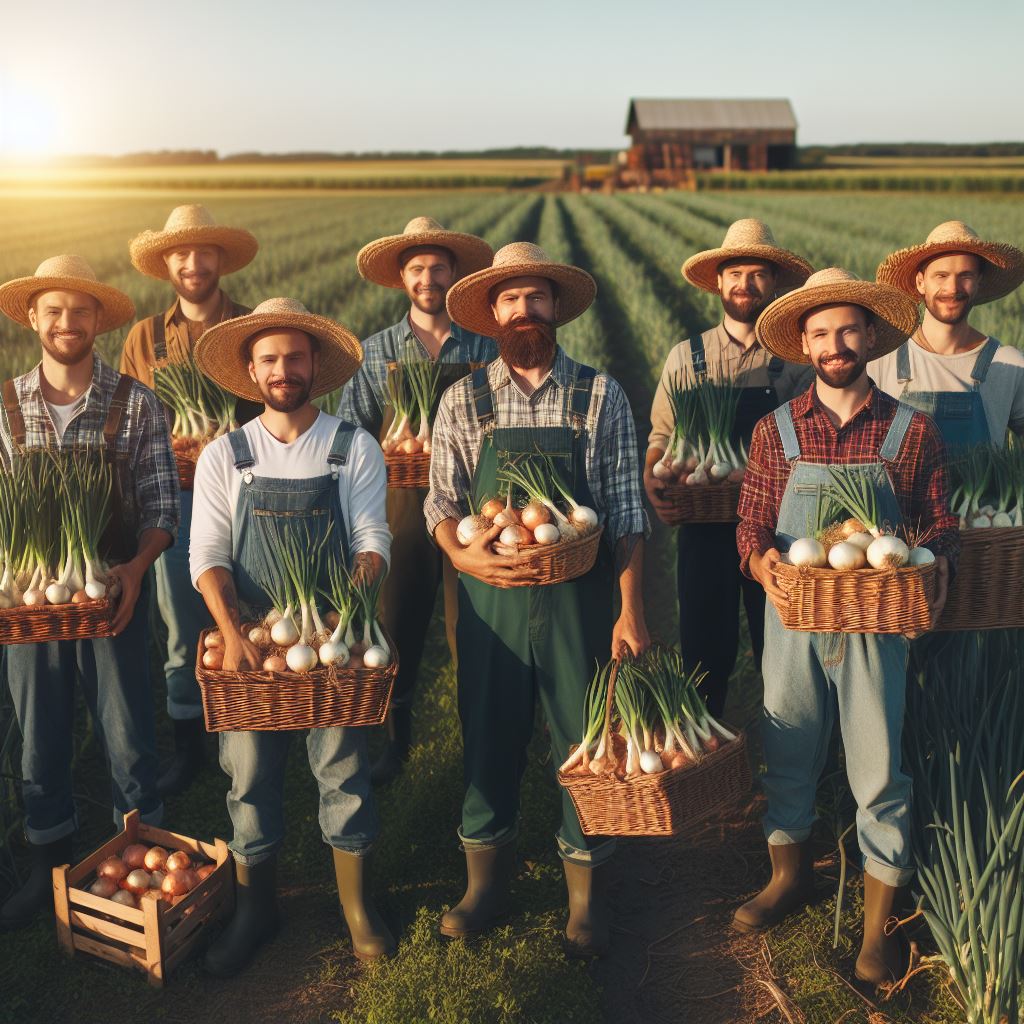Onion Storage Tips Post-Harvest
Last Updated on March 2, 2024
Introduction
Importance of proper onion storage post-harvest
Onion Storage Tips Post Harvest: Proper storage of onions after harvest is crucial to maintain their quality and prevent spoilage.
By implementing effective storage techniques, farmers and consumers can prolong the shelf life of onions
and minimize losses.
Overview of the blog post content
In this blog section, we will discuss various onion storage tips post-harvest to help you preserve the freshness and flavor of your onions.
From selecting the right storage location to managing temperature and humidity levels, we will cover practical guidelines for successful onion storage.
Additionally, we will explore different storage methods and explain their pros and cons. By the end of this blog post, you will have a comprehensive understanding of how to store onions effectively and extend their usability.
So, let’s dive into the world of onion storage and learn how to maximize the potential of this versatile vegetable!
Factors to Consider Before Storing Onions
Curing onions before storage
- After harvesting, allow onions to dry in a ventilated area for about two weeks.
- Curing helps remove excess moisture and toughens the outer skin of onions.
- Avoid curing onions if they are damaged or diseased as it can lead to rot.
Assessing onion maturity and quality
- Check if the onions have reached maturity by examining their size, color, and firmness.
- Mature onions will have a papery outer skin and a strong, pungent smell.
- Discard any immature or over-ripe onions to ensure better storage quality.
Sorting and removing damaged or diseased onions
- Inspect all the onions carefully for signs of damage, such as bruises or rot.
- Remove any damaged or diseased onions to prevent the spread of fungi and bacteria.
- Separate onions with thick necks or soft spots, as they are prone to spoilage.
- Create different categories based on onion size and quality to store them accordingly.
- Store onions with similar sizes together as they will have similar storage requirements.
- Keep onions that have been cut or damaged separate from whole onions.
- Avoid storing onions with other strong-smelling produce as they can absorb odors.
- Do not store onions near potatoes, as they can cause each other to spoil faster.
- Store onions in a cool, dry, and well-ventilated area to prevent sprouting and rotting.
- Ideal storage temperatures for onions range from 32-40°F (0-4°C).
- High humidity can lead to mold growth, so maintain humidity levels below 70%.
- Use mesh bags or open containers to store onions instead of closed plastic bags.
Additional points
- The mesh bags allow air circulation, preventing moisture buildup and extending onion shelf life.
- Check on the stored onions regularly to remove any sprouting or rotting ones.
- Use the sprouting or rotting onions first and discard the rest to avoid contamination.
- Don’t wash onions before storing as it can promote decay and reduce their shelf life.
- Only clean onions with dry cloth or brush if necessary, right before using them.
- Consider storing excess onions in alternative ways for long-term preservation.
- Options include freezing chopped or sliced onions or dehydrating them for onion powder.
In summary, before storing onions, it is crucial to cure them, assess their maturity and quality, and sort out damaged or diseased ones.
Additionally, proper storage conditions, such as temperature, humidity, and ventilation, must be maintained. Regular monitoring and proper cleaning practices will ensure that the stored onions stay fresh for an extended period.
Read: Carrot Harvest: Getting Timing Right
Choosing the Ideal Storage Location
Temperature and humidity requirements
Ensure the storage location has a cool temperature between 32°F to 40°F (0°C to 4.4°C).
Maintain a humidity level of 65% to 70% to prevent onions from drying out.
Avoid areas with high humidity, as it can lead to mold or rot.
Importance of proper ventilation
Select a storage space with good air circulation to prevent onion spoilage.
Proper ventilation helps remove excess moisture and keeps onions fresh.
Avoid storing onions in sealed containers or plastic bags, as they need airflow.
Protecting onions from direct sunlight and pests
Choose a dark storage area to shield onions from direct sunlight.
Sun exposure can cause greening and sprouting, compromising their quality.
Keep onions away from ethylene-producing fruits, as they accelerate spoilage.
Place traps or use natural repellents to ward off pests, such as mice and insects.
Read: Pumpkin Picking: Perfect Timing Tips
Different Onion Storage Methods
Mesh bags or onion storage racks
Mesh bags and onion storage racks are popular storage options for onions. They provide good airflow, preventing moisture accumulation that could cause rot.
The mesh bags also allow you to see the onions easily, making it convenient to check for any spoiled ones. Simply place the onions in the bags or racks, ensuring they are spread out to avoid overcrowding. Store them in a cool, dry place like a pantry or basement.
Wooden crates or boxes
Wooden crates or boxes are another excellent storage method for onions. They provide a dark environment, which helps prevent the onions from sprouting or turning green.
Make sure to choose crates or boxes with slatted sides to allow for better air circulation. Line the bottom of the crates with dry straw or newspaper to absorb any excess moisture.
Place the onions in a single layer, avoiding stacking them too high to avoid crushing. Similar to mesh bags, store the wooden crates or boxes in a cool, dry area.
Hanging onion braids or nets
Hanging onion braids or nets are a traditional and space-saving storage option for onions. These methods allow the onions to hang freely, eliminating the risk of bruising or pressure points.
To create an onion braid, select fully cured onions with long and sturdy stems. Tie their stems together and start braiding, adding more onions as you go.
Hang the finished braid in a cool, dry location. Make sure the onions have enough space between them for better airflow. Alternatively, you can use onion nets to hang individual onions. Just place each onion in a net and hang them in a well-ventilated area.
By using any of these storage methods, you can prolong the shelf life of your onions and ensure you have a fresh supply all year round.
Remember to check the onions regularly for any signs of spoiling or sprouting. Remove any affected ones to prevent them from affecting the others.
In addition to the storage methods discussed above, there are a few general tips to follow when storing onions
- Keep them cool: Onions prefer temperatures between 32°F to 40°F (0°C to 4°C). Avoid storing them near heat sources or direct sunlight.
- Avoid storing with certain produce: Onions release gases that can accelerate the spoilage of certain fruits and vegetables like potatoes and apples. Keep them separate to avoid this.
- Remove any excess dirt: Before storing, gently brush off any loose dirt on the onions. Do not wash them, as moisture can promote rotting.
- Inspect regularly: Check your stored onions frequently for any signs of spoilage or sprouting. This will allow you to discard any affected ones promptly.
Remember, proper onion storage is crucial to maintaining their quality and flavor. By following these storage methods and tips, you can enjoy fresh and delicious onions for an extended period.
Read: Hop Harvesting for Craft Brewing

Tips for Maintaining Onion Storage Conditions
Monitoring temperature and humidity levels
Regularly check and adjust the temperature in the onion storage area to maintain optimal conditions
Keep the temperature between 0 to 4 degrees Celsius (32 to 39 degrees Fahrenheit) to prevent sprouting and decay.
Install a humidity meter to monitor and maintain humidity levels between 65% to 70%.
Use a dehumidifier or ventilation system to control excess moisture in the storage area.
Avoid direct exposure to sunlight and high temperatures, which can cause faster deterioration.
Inspecting onions regularly for signs of spoilage
Inspect onions carefully before storage, discarding any damaged or diseased ones.
Check stored onions regularly for signs of mold, rot, or sprouting.
Remove any damaged or spoilt onions immediately to prevent the spread of decay.
Dispose of spoiled onions properly to avoid contamination to healthy ones.
If possible, separate onions by quality to prevent the spread of spoilage if detected.
Proper handling and avoiding unnecessary movement:
Handle onions carefully to minimize bruising and damage during storage.
Avoid dropping or throwing onions, as this can cause internal injuries and rot.
Use appropriate containers, such as mesh bags or crates, to allow proper airflow
Avoid stacking onions too high to prevent physical damage and excessive pressure
Minimize movement of onions to prevent mechanical stress that can lead to spoilage.
By following these tips, you can maintain the quality and freshness of your stored onions for a longer time. Proper temperature and humidity control, regular inspections, and careful handling are key to preventing spoilage and maximizing the shelf life of onions.
Read: Grape Harvesting for Winemaking
See Related Content: Maximizing Small-Scale Farming
Extending the Shelf Life of Onions
Freezing onions for long-term storage
- Peel and chop the onions into desired sizes.
- Flash freeze the chopped onions on a baking sheet for about an hour.
- Transfer the frozen onions into freezer-safe bags, removing as much air as possible.
- Label the bags with the date and freeze for up to 12 months.
- Thaw frozen onions before using and use them in cooked dishes, soups, or stews.
Dehydrating onions for use in cooking
- Thinly slice the onions or chop them into small pieces.
- Spread the onion slices or pieces in a single layer on dehydrator trays.
- Dry the onions at a temperature of around 135°F (57°C) for 8-12 hours.
- Once fully dehydrated, the onions should be brittle and break easily.
- Store the dehydrated onions in airtight containers away from moisture and light.
- Rehydrate the dried onions by soaking them in water for 15-30 minutes before using in recipes.
Preserving onions through pickling or canning
1. Select firm and fresh onions for pickling.
2. Peel and slice the onions into desired shapes and sizes.
3. Prepare a pickling solution using vinegar, water, salt, and desired spices.
4. Bring the pickling solution to a boil and let it simmer for a few minutes.
5. Pack the sliced onions into sterilized jars and pour hot pickling solution over them.
6. Leave ½ inch of headspace in the jars and ensure the onions are fully submerged.
7. Remove air bubbles and seal the jars tightly with lids.
8. Process the jars in a boiling water canner for the recommended time based on altitude and jar size.
9. After processing, allow the jars to cool and check for a proper seal before storing in a cool, dark place.
10. Pickled onions can be stored for several months or even up to a year.
By following these methods, you can extend the shelf life of your onions and preserve their flavor for longer durations. Whether you choose freezing, dehydrating, or pickling, each technique offers unique advantages for different culinary purposes.
Experiment with these methods and enjoy the convenience of having flavorful onions at hand throughout the year.
Common Mistakes to Avoid in Onion Storage
In order to ensure the longevity and quality of your onions, it’s important to avoid these common mistakes:
Storing onions near ethylene-sensitive produce
Placing onions in close proximity to ethylene-sensitive fruits and vegetables can accelerate spoilage.
Fruits like apples, bananas, and tomatoes, as well as potatoes, should be stored separately from onions
Ethylene gas released by these produce items can cause onions to deteriorate faster and become soft or mushy.
Exposing onions to excessive moisture or heat
Onions should be stored in a cool, dry, and well-ventilated area to prevent them from becoming moldy or sprouting.
Avoid storing onions in plastic bags or containers that can trap moisture and promote rot.
Humidity levels above 70% can increase the likelihood of spoilage, so make sure the storage area is adequately dry.
Excessive heat can also cause onions to sprout or soften, so avoid storing them near stoves, heaters, or direct sunlight.
Neglecting to check onions regularly for spoilage
Regularly inspect your stored onions for signs of deterioration, rot, or sprouting.
Remove any damaged or spoiled onions immediately to prevent the spread of decay to other onions.
Remember that one bad onion can spoil the rest, so it’s crucial to monitor their condition periodically.
If you notice any onions with green sprouts, separate them from the rest as they have a shorter shelf life.
By avoiding these common mistakes, you can maximize the shelf life of your onions and enjoy their freshness for longer periods of time.
Conclusion
Recap of key points discussed in the blog post:
Proper curing and drying of onions after harvest is crucial for long-term storage.
Onions should be stored in a cool, dry, and well-ventilated area to prevent mold and sprouting.
It is important to inspect onions regularly and remove any spoiled or damaged ones to avoid spoilage.
Storing onions away from certain food items like potatoes and fruits can help prevent premature spoilage.
Different onion varieties have different storage lifespans, so it is necessary to know the specific requirements.
Encouragement to implement proper onion storage practices:
By following these onion storage tips, you can ensure that your harvest lasts for months, providing you with fresh and flavorful onions throughout the year. Take the time to properly care for your onions, and you will be rewarded with high-quality produce.
Final thoughts and call-to-action for readers to share their experiences or ask questions:
We hope these tips have been helpful in guiding you towards successful onion storage. Now we want to hear from you! Have you tried any of these storage techniques?
Do you have any other tips to add? Share your experiences or ask any questions in the comments below. Let’s continue the conversation and help each other become better onion storers!


